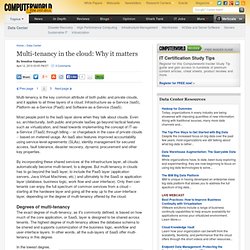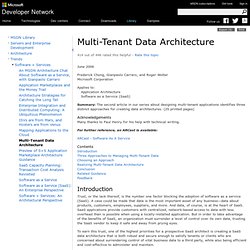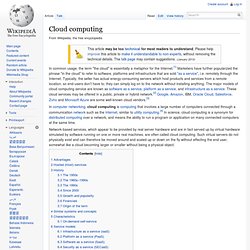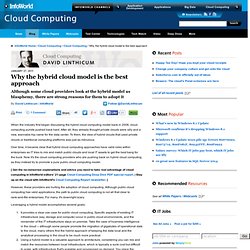

Multi-tenancy in the cloud: Why it matters. By Sreedhar Kajeepeta April 12, 2010 03:05 PM ET Multi-tenancy is the key common attribute of both public and private clouds, and it applies to all three layers of a cloud: Infrastructure-as-a-Service (IaaS), Platform-as-a-Service (PaaS) and Software-as-a-Service (SaaS).

Most people point to the IaaS layer alone when they talk about clouds. Even so, architecturally, both public and private IaaSes go beyond tactical features such as virtualization, and head towards implementing the concept of IT-as-a-Service (ITaaS) through billing -- or chargeback in the case of private clouds -- based on metered usage. An IaaS also features improved accountability using service-level-agreements (SLAs), identity management for secured access, fault tolerance, disaster recovery, dynamic procurement and other key properties. By incorporating these shared services at the infrastructure layer, all clouds automatically become multi-tenant, to a degree. Multi-Tenant Data Architecture. June 2006 Frederick Chong, Gianpaolo Carraro, and Roger Wolter Microsoft Corporation Applies to: Application Architecture Software as a Service (SaaS) Summary: The second article in our series about designing multi-tenant applications identifies three distinct approaches for creating data architectures. (25 printed pages) Acknowledgements Many thanks to Paul Henry for his help with technical writing.

For further reference, an ARCast is available: Hybrid cloud. In common usage, the term "the cloud" is essentially a metaphor for the Internet.[1] Marketers have further popularized the phrase "in the cloud" to refer to software, platforms and infrastructure that are sold "as a service", i.e. remotely through the Internet.

Typically, the seller has actual energy-consuming servers which host products and services from a remote location, so end-users don't have to; they can simply log on to the network without installing anything. WAN optimization. WAN optimization is a collection of techniques for increasing data transfer efficiencies across wide-area networks (WANs).

In 2008, the WAN optimization market was estimated to be $1 billion,[1] and was to grow to $4.4 billion by 2014 according to Gartner,[2] a technology research firm. In 2015 Gartner estimated the WAN optimization market to be a $1.1 billion market.[3] The most common measures of TCP data-transfer efficiencies (i.e., optimization) are throughput, bandwidth requirements, latency, protocol optimization, and congestion, as manifested in dropped packets.[4] In addition, the WAN itself can be classified with regards to the distance between endpoints and the amounts of data transferred. Two common business WAN topologies are Branch to Headquarters and Data Center to Data Center (DC2DC).
Component techniques of Branch WAN Optimization include deduplication, wide area file services (WAFS), SMB proxy, HTTPS Proxy, media multicasting, web caching, and bandwidth management.
Data Cloud. Why the hybrid cloud model is the best approach. January 27, 2011 Follow @DavidLinthicum When the industry first began discussing the hybrid cloud computing model back in 2008, cloud computing purists pushed back hard.

After all, they already thought private clouds were silly and a new, wannabe-hip name for the data center. To them, the idea of hybrid clouds that used private clouds or traditional computing platforms was just as ridiculous. Over time, it became clear that hybrid cloud computing approaches have valid roles within enterprises as IT tries to mix and match public clouds and local IT assets to get the best bang for the buck. . [ Get the no-nonsense explanations and advice you need to take real advantage of cloud computing in InfoWorld editors' 21-page Cloud Computing Deep Dive PDF special report. | Stay up on the cloud with InfoWorld's Cloud Computing Report newsletter. ] However, these providers are hurting the adoption of cloud computing.
Leveraging a hybrid model accomplishes several goals: Virtual private cloud. A Virtual Private Cloud (VPC) is an on demand configurable pool of shared computing resources allocated within a public cloud environment, providing certain level of isolation between the different organizations (denoted as users hereafter) using the resources.

The isolation between one VPC user and all other users of the same cloud (other VPC users as well as other public cloud users) is achieved normally through allocation of a Private IP Subnet and a virtual communication construct (such as a VLAN or a set of encrypted communication channels) per user. In a VPC solution, the previously described mechanism, providing isolation within the cloud, is accompanied with a VPN function (again, allocated per VPC user) that secures, by means of authentication and encryption, the remote access of the organization to its VPC cloud resources. VPC is most commonly used in the context of cloud infrastructure services (IaaS). VPC implementations[edit] See also[edit] References[edit]